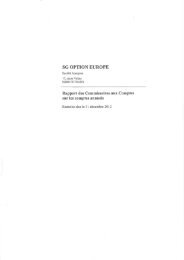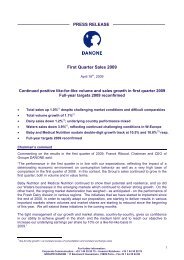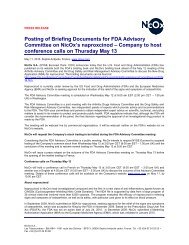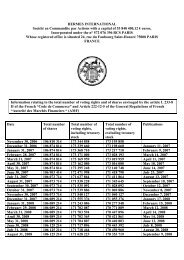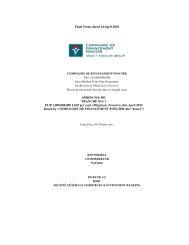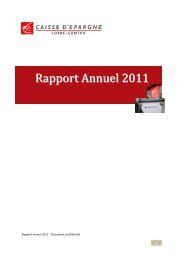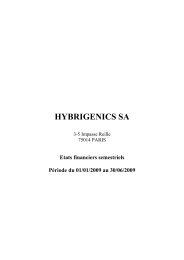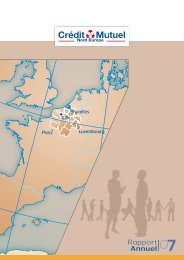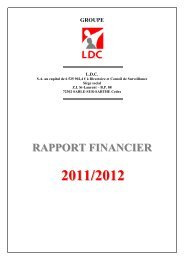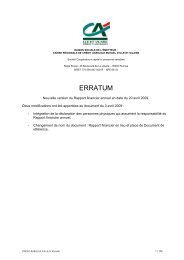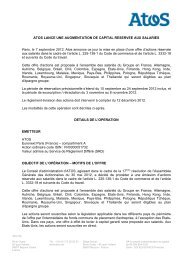Financial Reporting - Rexel
Financial Reporting - Rexel
Financial Reporting - Rexel
You also want an ePaper? Increase the reach of your titles
YUMPU automatically turns print PDFs into web optimized ePapers that Google loves.
Impairment losses recognized in respect of cash-generating units are allocated first to reduce the carrying<br />
amount of any goodwill allocated to the cash-generating unit (or group of units) and then, to reduce the<br />
carrying amount of the other assets in the unit (or group of units) on a pro rata basis.<br />
Calculation of the Recoverable Amount<br />
The recoverable amount of the Group’s investments in held-to-maturity securities and receivables carried at<br />
amortized cost is calculated as the present value of estimated future cash flows, discounted at the original<br />
effective interest rate (i.e., the effective interest rate computed at initial recognition of these financial assets)<br />
when the effect is material.<br />
The recoverable amount of other assets is the greater of their fair value less costs to sell and value in use. In<br />
assessing value in use, the estimated future cash flows are discounted to their present value using a<br />
discount rate before tax that reflects current market assessments of the time value of money and the risks<br />
specific to the asset. For an asset that does not generate largely independent cash inflows, the recoverable<br />
amount is determined for the cash-generating unit to which the asset belongs. The Group performs<br />
impairment tests of goodwill at the country level, which represents the lowest level within the entity at which<br />
operations are monitored by management for the purpose of measuring return on investment.<br />
Reversal of Impairment Losses<br />
An impairment loss in respect of a held-to-maturity security or receivable carried at amortized cost is<br />
reversed if the subsequent increase in recoverable amount can be related objectively to an event occurring<br />
after the impairment loss was recognized.<br />
Impairment losses in respect of goodwill may not be reversed.<br />
With respect to other assets, an impairment loss is reversed if there has been a change in the estimates<br />
used to determine the recoverable amount.<br />
An impairment loss is reversed only to the extent that the asset’s carrying amount does not exceed the<br />
carrying amount that would have been determined, net of depreciation or amortization, if no impairment loss<br />
had been recognized.<br />
2.9 | Inventories<br />
Inventories are mainly composed of goods held for resale. Inventories are stated at the lower of cost and net<br />
realizable value. Cost is calculated by reference to a first-in first-out basis, including freight in costs, net of<br />
any purchase rebates. Net realizable value is the estimated selling price at balance sheet date, less the<br />
estimated selling expenses, taking into account technical or marketing obsolescence and risks related to<br />
slow moving inventory.<br />
2.10 | <strong>Financial</strong> assets<br />
2.10.1 | Long-term investments<br />
Long-term investments principally include investments in non-consolidated companies and other<br />
shareholdings, deposits required for operating purposes, and loans.<br />
Investments in non-consolidated companies and other shareholdings are classified as assets available-forsale<br />
and measured at fair value. When fair value is not reliably measurable, investments are stated at cost<br />
less impairment losses when necessary. Changes in fair value are recognized in equity and transferred to<br />
profit or loss when the asset is sold or permanently impaired.<br />
2.10.2 | Held for trading instruments<br />
<strong>Financial</strong> instruments held for trading mainly include marketable securities and are stated at fair value, with<br />
any resulting gain or loss recognized in profit or loss.<br />
The fair value of financial instruments classified as held for trading is their quoted bid price at the balance<br />
sheet date. Change in fair value is recognized in profit or loss.<br />
2.10.3 | Trade and other accounts receivable<br />
Trade and other accounts receivable are measured initially at fair value and subsequently measured at<br />
amortized cost using the effective interest rate method (see note 2.13) less impairment losses.<br />
33



